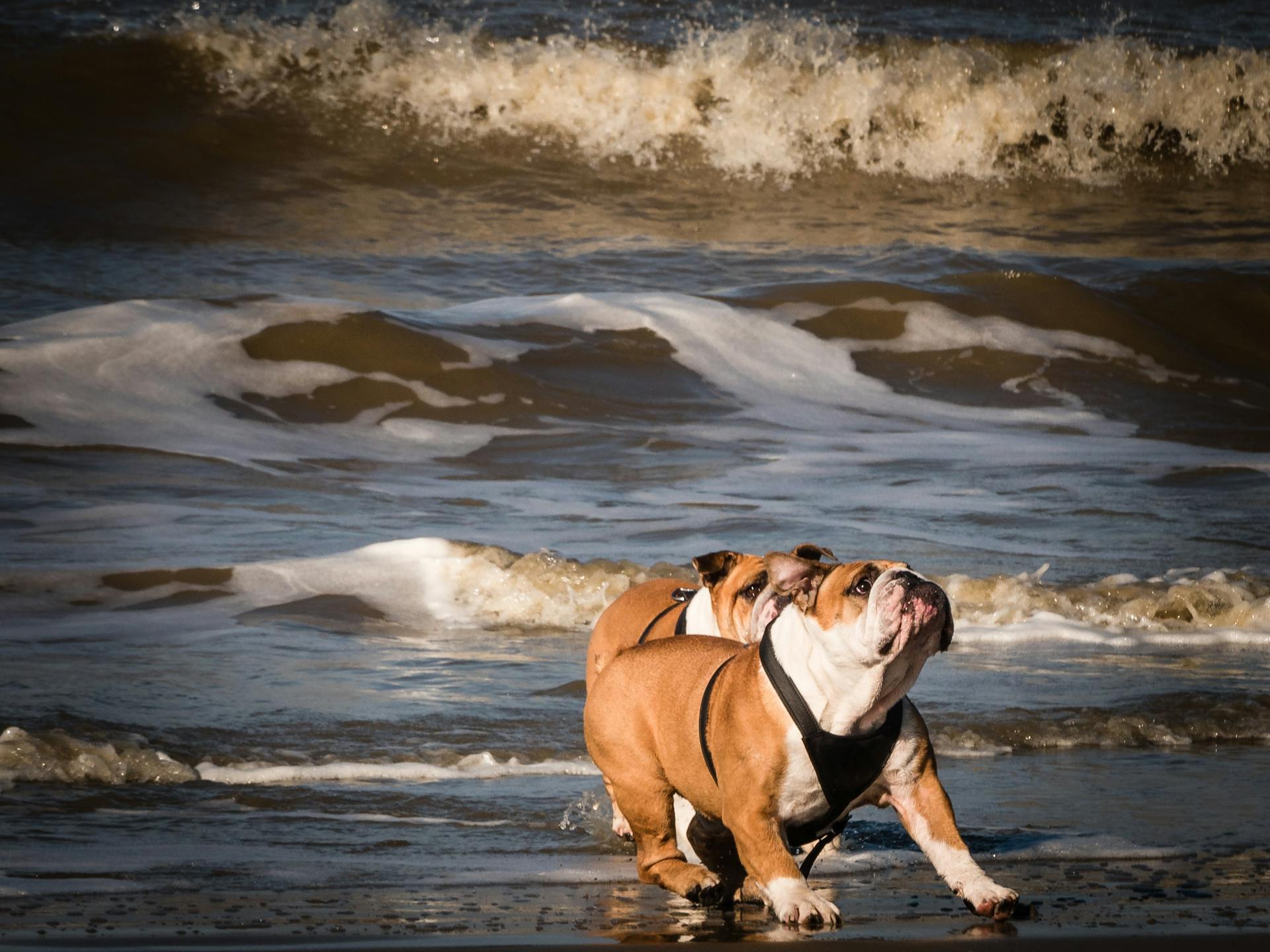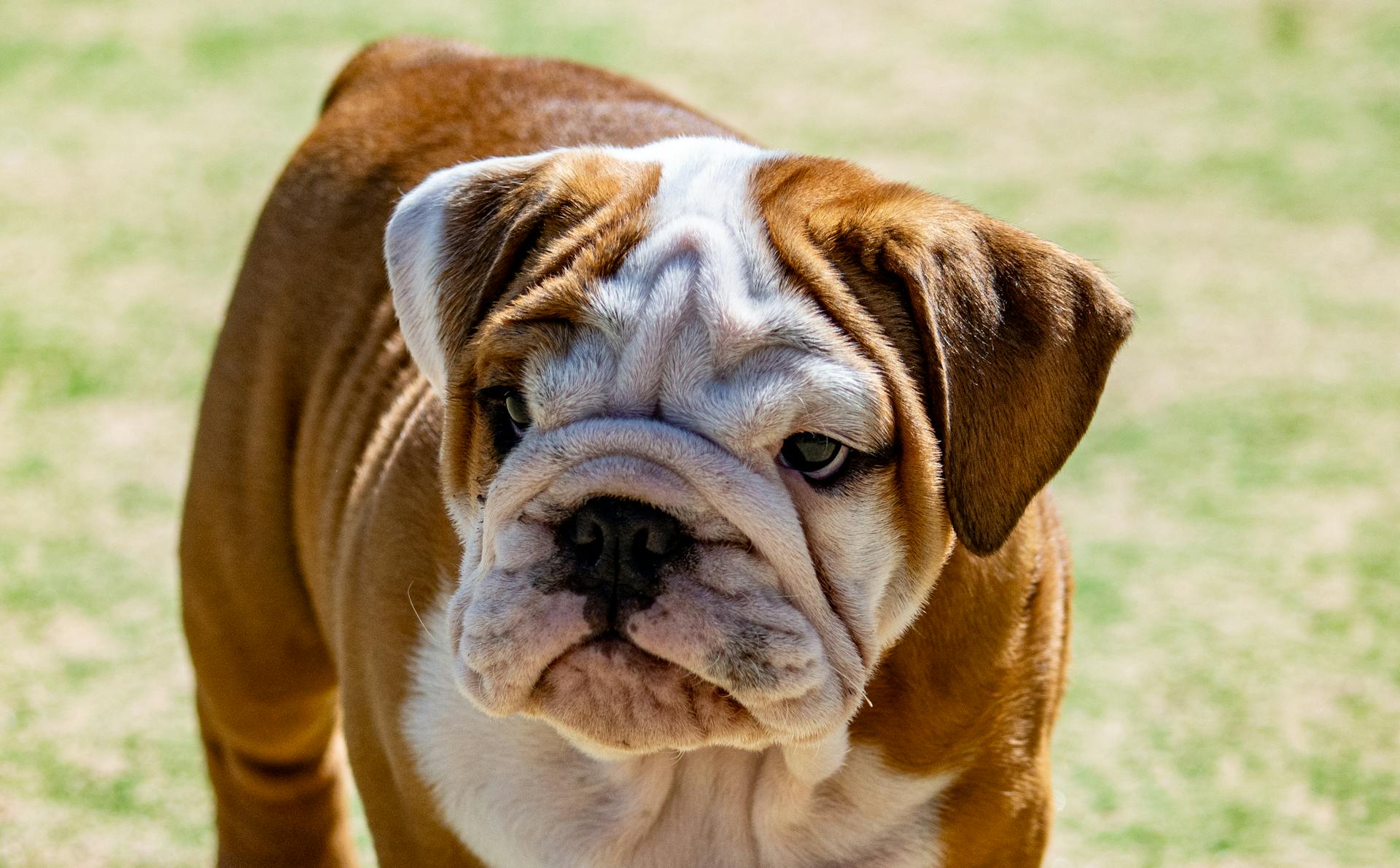
English Bulldogs are prone to hair loss due to their unique skin folds and wrinkles, which can trap moisture and create an ideal environment for skin infections.
Their skin folds can also lead to irritation and inflammation, causing hair loss in these areas.
In fact, studies have shown that up to 75% of English Bulldogs experience skin fold dermatitis, a condition that can lead to hair loss.
Regular grooming and cleaning of the skin folds is essential to prevent hair loss and skin infections.
For your interest: English Bulldog Hair
Causes
English bulldog hair loss can be caused by a range of factors, from pressure sores to skin cancer.
Friction from a collar can lead to hair loss, so if your bulldog wears a collar, make sure it's not too tight.
Nervous chewing or licking can also cause hair loss, especially if your bulldog is prone to anxiety.
Infections, such as ringworm or bacterial infections, can cause hair loss and skin conditions.
Mites, like mange mites, can infest your bulldog's skin, leading to hair loss and itching.
Genetics can also play a role in English bulldog hair loss, particularly in certain breeds that can develop hair loss in adulthood.
Here are some common signs of infection or infestation in English bulldogs:
- Hair loss around the ears, eyes, and mouth
- Oily skin
- Thickened skin
- Itching
- Inflammation
- Circular or irregular hair loss
- Infected crusts
Symptoms and Diagnosis
English bulldog hair loss can be a concerning issue for pet owners. Dog hair loss is typically an obvious condition and can occur at any age, in any breed, and anywhere on the body.
Symptoms of hair loss in English bulldogs may include overall thinning of the hair, hair loss around eyes and mouth, patches of complete hair loss, and foul odor. Itchiness, black or dark grey skin under hair loss, dry, scaly skin, and red, inflamed skin are also common symptoms.
A veterinarian should examine your English bulldog to determine the underlying cause of hair loss. The pattern of hair loss, skin condition around hair loss, and whether your pet is itching or uncomfortable will be taken into account during the diagnosis.
A unique perspective: English Bulldog Insurance
Here are some possible causes of hair loss in English bulldogs:
- Generalized hair loss could be a sign of mange or bacterial infection.
- Patches of hair loss could indicate conditions like ringworm, bacterial infection, mites, or mange.
- Hair loss in the rump and tail base area is often due to a flea allergy.
- Symmetrical hair loss could be a sign of adrenal gland disorder, thyroid disorder, or abnormal sex hormone levels.
Symptoms
Symptoms of hair loss in dogs can be quite varied, but some common signs include overall thinning of the hair, hair loss around the eyes and mouth, and patches of complete hair loss.
These patches can appear anywhere on the body and can be symmetrical, meaning they occur in the same place on both sides of the body.
Dog owners may also notice a foul odor or itchiness in the affected areas.
In some cases, the skin under the hair loss may appear black or dark grey, and the surrounding skin may be dry and scaly or red and inflamed.
Oozing moisture or bleeding around the area of hair loss is also a possible symptom, although this is typically a secondary condition.
Here are some common symptoms of alopecia in dogs:
- Mild to severe scratching
- Skin that is red, inflamed, thickened, oozing, bleeding, malodorous, or pigmented
- Skin with papules
Diagnosis
Diagnosis of hair loss in dogs is a crucial step in determining the underlying cause and finding effective treatment. A veterinarian's examination is essential to identify the pattern of hair loss, skin condition, and any signs of itching or discomfort.

Generalized hair loss could be a sign of mange or bacterial infection, while patches of hair loss might indicate conditions like ringworm, bacterial infection, mites, or mange. Hair loss in the rump and tail base area is often due to a flea allergy, and hair loss from the paws and face is sometimes environmental allergies (atopy).
Blood testing can help diagnose certain immune system conditions, hormone abnormalities, thyroid disorders, Cushing’s disease, and Diabetes mellitus. A veterinarian may also want to send a sample of the affected area to the laboratory for a biopsy if skin cancer or a tumor is suspected, or in persistent unresponsive skin lesions.
Skin impression smears can show the presence of bacteria, yeast, or inflammatory cells by pressing a microscopic slide on the affected area and analyzing it. Skin scraping can help detect the presence of mange mites by gently scraping the skin with a blade to gather hair follicles onto a slide.
Some ringworm species will glow a fluorescent green-yellow under ultraviolet light, which can be detected using luminescence. Allergen elimination trials may reveal an allergy to a certain food by feeding a hypoallergenic diet, treating fleas, or eliminating the use of certain shampoos or drugs.
Here are some diagnostic methods used to identify the underlying cause of hair loss in dogs:
- Pattern of hair loss
- Blood profile
- Biopsy
- Skin impression smears
- Skin scraping
- Luminescence
- Allergen elimination trials
- Allergy testing (skin and/or blood tests)
Alopecia Symptoms & Causes
Alopecia in dogs can manifest in various ways, making it essential to recognize the symptoms and understand the potential causes.
Mild to severe scratching is a common symptom of alopecia in dogs, and in severe cases, the skin may become red, inflamed, thickened, oozing, bleeding, malodorous, or pigmented.
The causes of alopecia in dogs are numerous and varied, including ectoparasites and bug bites, skin infections and allergies, genetic predispositions, autoimmune disorders, endocrine diseases, environmental causes, and nutritional causes.
Some common causes of hair loss in dogs include pressure sores, friction, nervous chewing or licking, trauma and/or scarring, post-surgical clipping, infection, ringworm, allergies, mites, abnormality in growth of the hair shaft, thyroid disorder, Cushing’s disease, sex hormone imbalance, chemotherapy, skin cancer, and genetics.
Here are some of the most common symptoms of alopecia in dogs:
- Mild to severe scratching
- Skin that is red, inflamed, thickened, oozing, bleeding, malodorous, or pigmented
- Skin with papules
It's worth noting that a veterinarian should be consulted to determine the underlying cause of alopecia in dogs, as the pattern of hair loss, skin condition, and whether the pet is itching or uncomfortable can provide valuable clues for diagnosis.
Treatment and Management
If your English Bulldog is experiencing hair loss, it's essential to identify the underlying cause to determine the best course of treatment.
Some hair loss can be treated with antibiotics, antifungals, or steroids, depending on the diagnosis.
Antibiotics can treat bacterial infections, while antifungals can treat yeast and ringworm infections.
Steroids may be required to treat certain skin conditions.
Immunosuppressive Drugs or Anti-cytokine Drugs may be needed for environmental allergy (Atopy) control.
Immunotherapy may be needed orally or by injection for allergy desensitization.
Behavioral medications can treat nervous chewing or licking.
Medicated shampoos or dips can treat cases of mange.
Hypoallergenic diets will often solve hair loss due to food allergies.
A fresh food diet contains essential healthy fats like Omega-6 and Omega-3, plus Zinc and amino acids that can work to calm inflammatory reactions to allergens.
Here are some dietary suggestions to help your English Bulldog's allergies:
Some hair loss may be permanent, especially if caused by genetics, scarring, callouses, or pressure sores.
In some cases, hair loss may be reversible with proper treatment, such as thyroid medication or hormone therapy.
If your English Bulldog is experiencing hair loss, it's essential to consult with a veterinarian to determine the best course of treatment.
A fresh viewpoint: English Bulldog Hip Dysplasia Treatment
Recovery and Prevention
Recovery from hair loss in English bulldogs may take more than one treatment session, depending on their predisposition to skin infections. Always follow your veterinarian's instructions and be prepared for follow-up appointments to ensure the problem is resolving.
It's essential to monitor your dog's skin and hair regrowth, and communicate any changes or concerns to your veterinarian. This will help them adjust the treatment plan accordingly.
To prevent hair loss in English bulldogs, checking for fleas in the house is a good starting point. Ruling out mange is also crucial.
Providing a calm atmosphere for your dog can help prevent hair loss. This is especially important for English bulldogs, which can be prone to stress-related hair loss.
Looking into hypoallergenic dog food options may help if your dog's symptoms are minimal. This is because some dog foods can cause allergic reactions that lead to hair loss.
If you don't see any improvement after implementing these strategies, it's essential to have your pup examined by a veterinary professional.
Frequently Asked Questions
Should I be concerned about my dog losing hair?
Typically, dog hair loss is normal during shedding season or for certain breeds, but sudden hair loss may indicate an underlying health issue
How do you treat bald spots on dogs?
Treating bald spots on dogs typically involves antibiotics, antifungals, or steroids, depending on the underlying cause of the hair loss. Consult a veterinarian to determine the best course of treatment for your dog's specific condition
How do you treat post clipping alopecia in dogs?
Post clipping alopecia in dogs can be treated with veterinary-prescribed medications, such as melatonin and levothyroxine, which may be given orally to promote hair growth
Why is my bulldog shedding so much?
English bulldogs shed heavily due to seasonal temperature and daylight changes, and may also experience excessive shedding due to allergies
How can I reduce my dogs hair loss?
Ensure your dog stays hydrated to reduce hair loss, as dehydration is a common cause of excessive shedding
Featured Images: pexels.com


